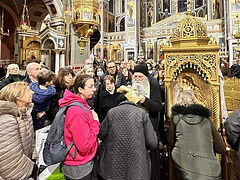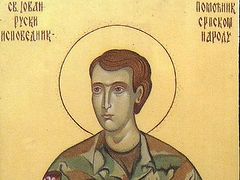New Prokopion, Evia, Greece, May 23, 2024
 Photo: orthodoxianewsagency.gr
Photo: orthodoxianewsagency.gr
This year’s edition of the annual Pilgrimage to St. John the Russian drew more than 1,500 Orthodox faithful, eager to venerate the beloved saint.
The holy walk, held on Sunday, May 19, marks the 9th annual Pilgrimage organized by the Region of Central Greece with the blessing and support of the Metropolis of Chalkida. This year’s event also marked the 100th anniversary of the arrival of St. John’s reliquary from Cappadocia to Evia, reports the Orthodoxia News Agency.
The pilgrimage, more than 11 miles long, winds through a landscaped and marked forest path. Food, drink, and commemorative hats and shirts were distributed along the way.
 Photo: orthodoxianewsagency.gr
Photo: orthodoxianewsagency.gr
The pilgrimage ended at the Church of St. John the Russian in New Prokopion, where his incorrupt relics are kept.
***
 Photo: pravoslavie.ru St. John the Russian was born in Little Russia around 1690, and raised to love God and His Church. He took part in the Russo-Turkish War, and in 1711 he was captured by the Tatars, and handed over to the commander of the Turkish cavalry, who took him home with him to the village of Prokopion.
Photo: pravoslavie.ru St. John the Russian was born in Little Russia around 1690, and raised to love God and His Church. He took part in the Russo-Turkish War, and in 1711 he was captured by the Tatars, and handed over to the commander of the Turkish cavalry, who took him home with him to the village of Prokopion.
Although some of those captured were swayed, St. John refused to renounce his Orthodox faith and to become a Muslim, for which he was often subjected to tortures at the hands of his master. St. John bravely resisted, saying, “You cannot turn me from my holy Faith by threats, nor with promises of riches and pleasures. I will obey your orders willingly, if you will leave me free to follow my religion. I would rather surrender my head to you than to change my faith. I was born a Christian, and I shall die a Christian.” St. John’s blessed courage mixed with humility softened his master’s heart, and he no longer attempted to convert the pious Russian.
St. John lived and worked in the stables, rejoicing to have a manger for a bed, as did the Lord Himself in His Nativity. He served his master with perfect obedience, and changed the hearts of those around him with his life full of virtues. At night he would often go to a nearby church to keep vigil.
Towards the end of his earthly life, St. John fell ill, and called for the local priest to bring him the precious Body and Blood of the Lord for him to commune one last time. Fearing to go to house of a Turkish commander, the priest sent the Gifts concealed in an apple. St. John rejoiced to commune of the Lord Jesus Christ, and reposed on May 27, 1730. His master allowed him to have a Christian burial.
Three and a half years later, the same priest received word in a dream that St. John’s relics were incorrupt. His body was soon transferred to the Church of St. George and placed in a special reliquary. The new saint was soon glorified by innumerable miracles, and faithful from all came to venerate his wonderworking relics.
In 1924, with the population exchange between Greece and Turkey, his relics were taken to the island of Evia, and in 1951 were placed in a new church dedicated to him. Thousands flock to his church and relics every year on his feast day. St. John’s help is especially sought by travelers and shippers.
Follow OrthoChristian on Twitter, Vkontakte, Telegram, WhatsApp, MeWe, and Gab!



